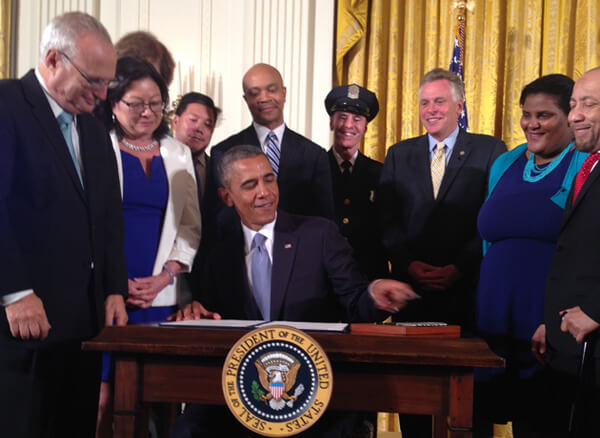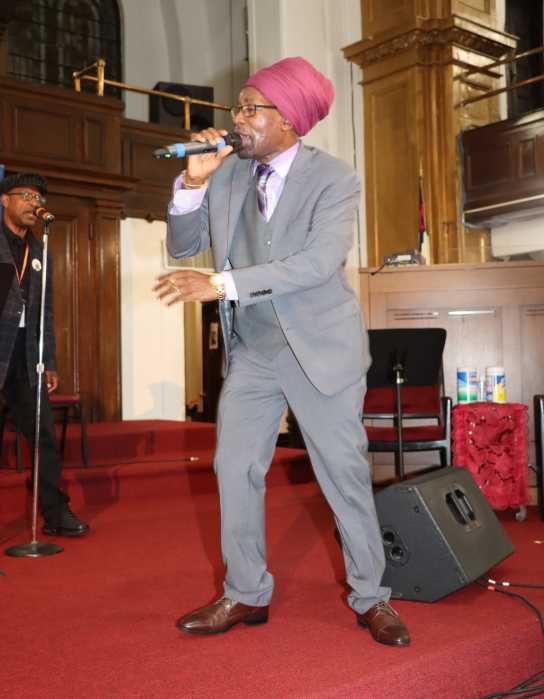Designer Norman Norell was born Norman David Levinson in Noblesville, Indiana. | MILTON H. GREENE/ COURTESY OF JOSHUA GREENE
The image of Lauren Bacall, sleek and leonine, throwing her head back in husky laughter at, say, 21 or El Morocco, poured into a skin-tight sequin sheath, has always seemed to me the visual essence of the sophisticated Manhattan we all came here seeking. In this case, the shimmering gown would have been designed by a man with a name as euphoniously alluring as Bacall’s herself, Norman Norell (1900-72), whose couture genius is being celebrated at the Museum at Fashion Institute of Technology, with the exhibit, “Norman Norell: Dean of American Fashion.” There is also a big, beautiful Rizzoli book, “Norell: Master of American Fashion,” written by designer Jeffrey Banks (who curated the show with museum deputy director Patricia Mears) and Doria de la Chapelle.
It is easily one of the best fashion exhibits in recent memory — and maybe the most beautiful — for these dresses are real jewels in themselves, masterpieces of refined understatement in the most luxurious of fabrications and diabolically clever cuts, creating that distinctive 1950s Vogue-Dovima glamorous hauteur. Even the earliest gown, from 1932, a crisp white organdy tea gown — to be worn of a summer’s afternoon — with a wide-brimmed picture hat, its salient feature a pair of enormous puffed sleeves, has this irresistible cachet, showing just how very early Norell’s genius evinced itself.
The Museum at FIT has gone all Norman Norell
And, yes, occupying pride of place front and center in the gallery is a trio of sequinned Norells owned by lifelong fashionista Bacall, who would wear Norell to a Dior fashion show and left a huge chunk of her fabled wardrobe to the school’s archive, including some 300 pairs of Pucci shantung pedal pushers.
“Because you never know when you’re going to need them,” chuckled Mears. “But so many celebrities loved Norell. Monroe owned several pieces, Ava Gardner, Greer Garson, Judy Garland, Streisand, Dinah Shore, also Gloria Swanson and Doris Day, whose films ‘Zaza’ and ‘That Touch of Mink’ we are showing clips from because Norell, who started as a costume designer, did them.
A Norell heathered oatmeal wool jersey shirtwaist dress with silk scarf and belt from 1971. | PHOTOGRAPH BY MARC FOWLER/ COURTESY OF KENNETH POOL COLLECTION
“Bacall’s pieces represent some of the archive’s finest Norells, and it was an added compliment that she had been a model and was so devoted to him, the ultimate compliment. With Norell, you could combine his sequins with a day jacket. He wore a Peterson sailor suit as a child [nee Norman David Levinson, in Noblesville, Indiana] — as all well-to-do kids did — which led him to do nautical themes throughout his collections, way before Gaultier. And he did pant suits even before Saint Laurent. He revolutionized ready-to-wear, making it luxe, totally functional but with glamour.
“I had always wanted to work with Jeffrey, whose books I’ve always admired, as well as his presentations at Parsons. I knew Norell was a lifelong obsession of his, from when he was a little boy in Washington, DC, and would make regular visits to the finest store in town to inspect the Norells in stock. I really wanted this show to be created and seen through this designer’s eye, as well as the collection of bridal designer Kenneth Pool, because half of the show is from his collection.We’re historians, so we love to get this different and unique kind of perspective. It was truly an honor and privilege to tell the story through Jeffrey’s eyes.”
I cornered the always suave and soigné Banks in the gallery and asked if he had ever met the great man himself.
“I met him about a month before he died,” Banks smiled, “He was doing a trunk show at Bonwit Teller. It was a month shy of my 18th birthday and I was working for Ralph [Lauren]. I think I told him I was going to the dentist and I ran to 56th and Fifth and was hiding behind the columns, gazing at my hero. Pat Mori, one of his models, saw me and came over, asking ‘Would you like to meet Mr. Norell?’ She brought me over to him, and I don’t think I said more than four words to him and he to me. He was extremely shy, like me. Actually, there’s a picture in the book which documents this that was done about 15 minutes before I met him. The New York Times was taking pictures of the event and, going through their photo archive, I found it.”
I told Banks that, after the almost grotesque excess of fashion, especially in this last seasonal showing, which literally had clown outfits and a lot of sheer craziness parading down the runway by some of the top names in the business, the cool, calm, and collected ethos of Norell’s work is like a palate cleanser.
“That’s what I love about him,” Banks replied. “There are about two dozen truly timeless garments here, which, if she could could fit in them, any woman would be happy to wear and they’re like 30 to 40 years old! They have this incredible, timeless quality, and the reason they look so good is because of the way they were made, with the best fabrics. Norell bought all his fabrics in Europe, even the silk linings, and the way they were constructed was the great revelation when we started to work on this show. That’s why we have this one dress turned inside out, so you can see how it was made.
“I have a whole chapter in the book about how the clothes were made. He would have 12-inch hems because, as he said, ‘For this kind of money you want to be able to lengthen or shorten it.’ Who does that, instead of urging women to just buy a new dress? Who would pipe the seams with chiffon? That is like couture workmanship, but they were all strictly ready-to-wear. Lauren Bacall would say, ‘I like this dress, but could you do it in black?’ And he would, but he would invoice it through Bonwit or Saks or Bergdorf’s because he felt it would be disloyal to his store who was loyal to him.”
Norell was gay in a high pressure business at a conservative time, and I wondered if he was, with all of his hard-won success, happy.
Norell grew up wearing sailor suits, and he produced countless versions throughout his career. | PHOTOGRAPH BY MARC FOWLER/ COURTESY OF KENNETH POOL COLLECTION
“I think he was happy, but he didn’t socialize with his clients because of his shyness,” Banks said. “If he had not been a designer, Norell would probably have been happy as an interior decorator. He loved buying antiques and showing off his apartment. His social life was basically antique shows on Saturday, theater every once in a while, and spending most of his time with his cabine of models, whom he took with him on his trips to Europe to buy fabric.
“He did have a boyfriend. John Moore was a designer, but not happy, an alcoholic who was drunk by 10 every morning. He was considerably younger than Norell and had gone to Parsons when he was considerably older than the other students, but he was a couple decades younger than Norell. For that time, it was kind of scandalous, although they were very discreet. Norell bought him an apartment right across the street from his place. Norell lived in a duplex in Amster Yard, in Turtle Bay, right next to Katharine Hepburn on East 49th Street.”
Norell helped Moore business-wise after he graduated from Parsons, and was such a big booster of him that he threatened to return his Coty fashion award one year when Moore wasn’t nominated.
“But Moore’s biggest claim to fame was designing Lady Bird Johnson’s inaugural yellow satin coat and gown. President Johnson wanted her to look terrific so he actually flew to New York to Norell’s showroom to talk about him designing her gown. Norell said, ‘I’m very flattered but there’s a young man you should meet. He’s from Texas, like you and Lady Bird, and I think you should have a Texan do it.’
“Moore did some sketches in yellow, for the yellow rose of Texas, and Lyndon liked what he saw, but said, ‘It doesn’t look rich enough. I want her to look like Jackie. Put some fur on it.’ So John added the sable cuffs and it was the biggest PR he ever got. Norman never had a lot of money — this was before the days when designers had huge licensing deals. When he died, he had half a million. He left a good part to John and the rest to Parsons. John quickly drank up most of what Norell had left him, closed up his business and flew back to Texas to run his family’s antique business. He was still drunk and still complaining about not having been left more money, years after Norell’s death.”
Liquor and drugs have proved the undoing of so many fashion talents, and Banks observed, “There’s so much pressure and even more today when you have to design not just collections, but pre-collections, there’s the licensing and having to design stores and ad campaigns. Norell’s was a simpler time. He had only one license, for his perfume, and that made more money its first year than he had ever seen. He was able to buy out his backers and own his company. He also did scarves, in-house, which expressed his love of color. They sold for $75-80, a lot of money in the 1950s, but women loved them as it was one way to have have an affordable Norell, printed in Switzerland and hand-rolled in Italy.
“You can still get the perfume at Bergdorf’s and Saks and Selfridges in London. The perfume was sold to another company and then to others, and was changed and became awful, but they have now gone back to the original formula and bottle, which is only slightly different because now it’s done in Baccarat, real crystal, not glass. It costs $1,000. What does the perfume smell like? Jasmine, very distinctive, and I cannot tell you how many people said, ‘I have to tell you that my mother or grandmother wore Norell.’ When they did the ad, there was no girl or spokesperson or model, just the bottle, revolutionary at the time.
“This show is the culmination of a lifetime dream. I’ve had folders full of Norell images for at least 10 years — to honor this great, great designer who, like Halston, Bill Blass, Stephen Sprouse, hailed from Indiana.”
NORELL: DEAN OF AMERICAN FASHION | Museum at Fashion Institute of Technology, Seventh Ave. at 27th St. | Through Apr. 14: Tue.-Fri., noon-8 p.m.; Sat., 10 a.m.-5 p.m. | Admission is free | fitnyc.edu/museum/exhibitions/norell.php


































